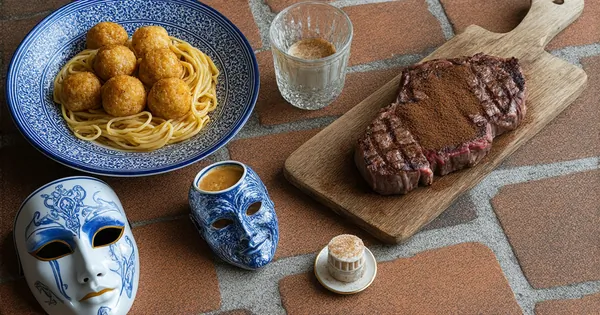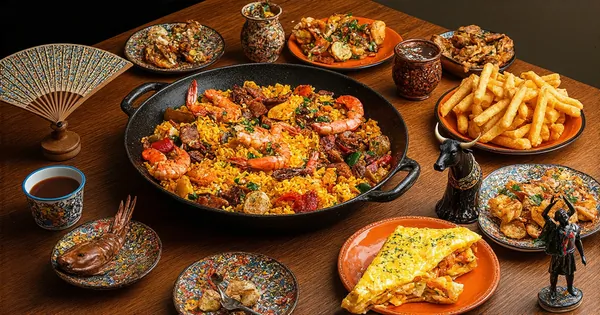
Italy
Navigate Italy's diverse culinary landscape with our expert guide. Discover authentic Italian cuisine from Rome's street food to regional specialties, making informed choices for a great travel experience.
European cuisine is a journey through history, a story told in ancient grains, celebrated wines, and techniques that have shaped global gastronomy. It's a continent where the food is inseparable from the land, or "terroir," with each region offering a distinct culinary dialect. To eat in Europe is to taste the legacy of empires, the bounty of diverse climates, and the enduring art of turning simple, local ingredients into a profound cultural experience.
More than just a word, "terroir" is the foundational philosophy of European food. It's the belief that the unique combination of a region's soil, climate, and traditional practices gives its products—from wine and cheese to olive oil and hams—a distinct character that cannot be replicated elsewhere. This concept underpins the entire system of protected origin food labels like France's AOC and Italy's DOC.
Long before refrigeration, survival in Europe depended on preserving the harvest. This necessity evolved into a culinary art form. Curing meats (prosciutto, salami), smoking fish (salmon, herring), pickling vegetables (cornichons, sauerkraut), and aging cheese are not just preservation methods but core techniques that create some of the continent's most iconic and complex flavors.
In Europe, bread is rarely a mere side dish; it is a central pillar of the meal and a symbol of community. From the crusty French baguette and the dense German rye to the Italian focaccia, each country and region has a signature loaf. The quality of a local bakery, or "boulangerie," is a point of neighborhood pride, and bread is the essential vessel for cheese, sauces, and soups.
Understand the traditional course structure to dine like a local.
How to shop at historic open-air markets with confidence and respect.
Europe's culinary identity is a tapestry of powerful, distinct zones. The Mediterranean south, from Spain to Greece, is defined by the "trinity" of olive oil, wheat, and wine, emphasizing fresh vegetables, seafood, and sun-drenched flavors. In contrast, Central and Eastern Europe's cuisine was shaped by colder climates, resulting in a heartier fare of smoked meats, fermented vegetables like sauerkraut, hearty potato dishes, and rich stews. Northern and Atlantic Europe, including Scandinavia and the British Isles, showcases a tradition of dairy farming, with exceptional butters and cheeses, alongside a reliance on preserved fish, game, and hardy root vegetables. Despite these contrasts, a shared reverence for bread, the art of cheese-making, and the ritual of the structured meal form a common European culinary heritage.
While both are foundational, the core difference lies in concept. Classic French cuisine is often seen as a "chef's cuisine," focused on complex techniques, mother sauces, and transforming ingredients into elegant, refined dishes. Italian cooking is a "cucina della nonna" (grandmother's kitchen), emphasizing the purity and high quality of a few simple, seasonal ingredients, allowing them to shine with minimal intervention.
The key is to walk a few blocks away from major tourist attractions. Look for places with menus written only in the local language, or with a short, handwritten list of daily specials. A reliable indicator of authenticity is a bustling lunch crowd of local office workers or families, especially if the restaurant specializes in just a few regional dishes.
Cheese is a living record of European history and agriculture. It was born from the need to preserve milk's nutrients through seasons of scarcity. Over centuries, this practical necessity evolved into a high craft, with each region's unique climate, terrain, and animal breeds producing distinct varieties. A cheese plate is not just a dish; it's a taste of a specific place's "terroir" and heritage.
Yes, this is a significant cultural difference. In Mediterranean countries like Spain and southern Italy, dinner is a social event that rarely begins before 9 PM, and often later. This is partly due to a climate where evenings are cooler and more pleasant, and the tradition of a long midday break or "siesta." In Northern and Central Europe, dinner is typically eaten much earlier, often between 6 PM and 8 PM.
Navigate Italy's diverse culinary landscape with our expert guide. Discover authentic Italian cuisine from Rome's street food to regional specialties, making informed choices for a great travel experience.
Navigate Spain's vibrant food scene with our expert guide. Discover authentic Spanish cuisine from Barcelona's tapas bars to regional specialties with quality-focused choices.
At Tasteplorers, our mission is to provide the most accurate and useful travel information in the world. To achieve this, all content on this site is created through our unique editorial framework. We utilize leading AI research tools, guided by our proprietary prompts, and a multi-stage validation process. This entire system is overseen by our editorial team to ensure everything we publish meets our high standards for accuracy, cultural nuance, and practical value for travelers.
Learn more about our Editorial Process and our Mission.
Discover the vibrant cuisines of Latin America & the Caribbean. Our expert guide covers everything from Mexican street food to Peruvian ceviche and market tips.
Explore Oceania's diverse food scene. Learn about Polynesian earth ovens, Fijian feasts, and the vibrant café culture of Australia and New Zealand.
Explore Southeast Asia's diverse food cultures from Thailand to Vietnam. Get expert tips on navigating spice levels, choosing quality vendors, and understanding the rich traditions of the region.
